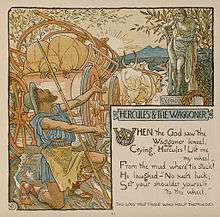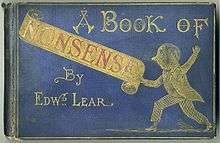Limerick (poetry)
A limerick (/ˈlɪmərɪk/[1]) is a form of verse, usually humorous and frequently rude, in five-line, predominantly anapestic[2] meter with a strict rhyme scheme of AABBA, in which the first, second and fifth line rhyme, while the third and fourth lines are shorter and share a different rhyme.[3] The following example is a limerick of unknown origin:
The limerick packs laughs anatomical
Into space that is quite economical.
But the good ones I've seen
So seldom are clean
And the clean ones so seldom are comical.[4]
The form appeared in England in the early years of the 18th century.[5] It was popularized by Edward Lear in the 19th century,[6] although he did not use the term. Gershon Legman, who compiled the largest and most scholarly anthology, held that the true limerick as a folk form is always obscene, and cites similar opinions by Arnold Bennett and George Bernard Shaw,[7] describing the clean limerick as a "periodic fad and object of magazine contests, rarely rising above mediocrity". From a folkloric point of view, the form is essentially transgressive; violation of taboo is part of its function.
Form

The standard form of a limerick is a stanza of five lines, with the first, second and fifth rhyming with one another and having three feet of three syllables each; and the shorter third and fourth lines also rhyming with each other, but having only two feet of three syllables. The third and fourth lines are usually anapaestic. The first, second and third are usually either anapaests or amphibrachs[8].
The first line traditionally introduces a person and a place, with the place appearing at the end of the first line and establishing the rhyme scheme for the second and fifth lines. In early limericks, the last line was often essentially a repeat of the first line, although this is no longer customary.
Within the genre, ordinary speech stress is often distorted in the first line, and may be regarded as a feature of the form: "There was a young man from the coast;" "There once was a girl from Detroit…" Legman takes this as a convention whereby prosody is violated simultaneously with propriety.[9] Exploitation of geographical names, especially exotic ones, is also common, and has been seen as invoking memories of geography lessons in order to subvert the decorum taught in the schoolroom; Legman finds that the exchange of limericks is almost exclusive to comparatively well-educated males, women figuring in limericks almost exclusively as "villains or victims". The most prized limericks incorporate a kind of twist, which may be revealed in the final line or lie in the way the rhymes are often intentionally tortured, or both. Many limericks show some form of internal rhyme, alliteration or assonance, or some element of word play. Verses in limerick form are sometimes combined with a refrain to form a limerick song, a traditional humorous drinking song often with obscene verses.
David Abercrombie, a phonetician, takes a different view of the limerick, and one which seems to accord better with the form.[10] It is this: Lines one, two, and five have three feet, that is to say three stressed syllables, while lines three and four have two stressed syllables. The number and placement of the unstressed syllables is rather flexible. There is at least one unstressed syllable between the stresses but there may be more – as long as there are not so many as to make it impossible to keep the equal spacing of the stresses.
Etymology
The origin of the name limerick for this type of poem is debated. The name is generally taken to be a reference to the City or County of Limerick in Ireland[11][12] sometimes particularly to the Maigue Poets, and may derive from an earlier form of nonsense verse parlour game that traditionally included a refrain that included "Will [or won't] you come (up) to Limerick?"[13]
Although the New English Dictionary records the first usage in England in 1898 and in the United States in 1902, in recent years several earlier examples have been documented, the earliest being an 1880 reference, in a Saint John, New Brunswick newspaper, to an apparently well-known tune,[14]
There was a young rustic named Mallory,
who drew but a very small salary.
When he went to the show,
his purse made him go
to a seat in the uppermost gallery.Tune: Won't you come to Limerick.[15]
Edward Lear

The limerick form was popularized by Edward Lear in his first Book of Nonsense (1846) and a later work, More Nonsense, Pictures, Rhymes, Botany, etc. (1872). Lear wrote 212 limericks, mostly considered nonsense literature. It was customary at the time for limericks to accompany an absurd illustration of the same subject, and for the final line of the limerick to be a variant of the first line ending in the same word, but with slight differences that create a nonsensical, circular effect. The humour is not in the "punch line" ending but rather in the tension between meaning and its lack.[16]
The following is an example of one of Edward Lear's limericks.
There was a Young Person of Smyrna
Whose grandmother threatened to burn her.
But she seized on the cat,
and said 'Granny, burn that!
You incongruous old woman of Smyrna!'
Lear's limericks were often typeset in three or four lines, according to the space available under the accompanying picture.
Variations

The limerick form is so well known that it has been parodied in many ways. The following example is of unknown origin:
There was a young man from Japan
Whose limericks never would scan.
And when they asked why,
He said "I do try!
But when I get to the last line I try to fit in as many words as I can."
Other parodies deliberately break the rhyme scheme, like the following example, attributed to W.S. Gilbert:
Comedian John Clarke has also parodied Lear's style:
There was an old man with a beard,
A funny old man with a beard
He had a big beard
A great big old beard
That amusing old man with a beard.[19]
The British wordplay and recreational mathematics expert Leigh Mercer (1893–1977) devised the following mathematical limerick:
This is read as follows:
See also
- Chastushka (Russian form with similar traits)
- Clerihew
- Double dactyl
- Lecherous Limericks, a book of limericks by Isaac Asimov
- Light verse
- Nonsense literature
- Quintain (any poetic form containing 5 lines such as tanka, cinquain, and limerick)
- "The Negotiation Limerick File", a song by Beastie Boys rapped in the form of a limerick
- There once was a man from Nantucket, a popular limerick subject
References
Notes
- "LIMERICK | meaning in the Cambridge English Dictionary". dictionary.cambridge.org. Retrieved 2019-12-12.
- Cuddon, J.A. (1999). The Penguin dictionary of literary terms and literary theory (4. ed.). London [u.a.]: Penguin Books. p. 458. ISBN 978-0140513639.
- Vaughn, Stanton (1904). Limerick Lyrics. Retrieved 6 October 2014.
- Feinberg, Leonard. The Secret of Humor. Rodopi, 1978. ISBN 9789062033706. p102
- An interesting and highly esoteric verse in limerick form is found in the diary of the Rev. John Thomlinson (1692–1761): 1717. Sept. 17th. One Dr. Bainbridge went from Cambridge to Oxon [Oxford] to be astronomy professor, and reading a lecture happened to say de Polis et Axis, instead of Axibus. Upon which one said, Dr. Bainbridge was sent from Cambridge,—to read lectures de Polis et Axis; but lett them that brought him hither, return him thither, and teach him his rules of syntaxis. From Six North Country Diaries, Publications of the Surtees Society, Vol. CXVIII for the year MCMX, p. 78. Andrews & Co., Durham, etc. 1910.
- Brandreth, page 108
- Legman 1988, pp. x-xi.
- "Limerick". Poetry Forms. Retrieved 31 May 2020.
- Legman 1988, p. xliv.
- Abercrombie, David, Studies in Phonetics and Linguistics 1965 Oxford University Press: Chapter 3 A Phonetician's View of Verse Structure.
- Loomis 1963, pp. 153–157.
- "Siar sna 70idí 1973 Lios Tuathail - John B Keane, Limericks, Skinheads". YouTube. Retrieved 6 October 2014.
- The phrase "come to Limerick" is known in American Slang since the Civil War, as documented in the Historical Dictionary of American Slang and subsequent posts on the American Dialect Society List. One meaning for the phrase, proposed by Stephen Goranson on ADS-list, would be a reference to the Treaty of Limerick, and mean surrender, settle, get to the point, get with the program.
- reported by Stephen Goranson on the ADS-list and in comments at the Oxford Etymologist blog
- Saint John Daily News, Saint John, New Brunswick Edward Willis, Proprietor Tuesday Nov 30, 1880 Vol. XLII, no. 281 page 4, column 5 [headline:] Wise and Otherwise
- Tigges, Wim. "The Limerick: The Sonnet of Nonsense?". Explorations in the Field of Nonsense. ed. Wim Tigges. 1987. page 117
- Merriam-Webster's Encyclopedia of Literature. 1995. ISBN 9780877790426. Retrieved 6 October 2014.
- Wells 1903, pp. xix-xxxiii.
- "Craig Brown: The Lost Diaries". the Guardian. Retrieved 6 October 2014.
- "Math Mayhem". lockhaven.edu. Retrieved 2019-05-29.
Bibliography
- Baring-Gould, William Stuart and Ceil Baring-Gould (1988). The Annotated Mother Goose, New York: Random House.
- Brandreth, Gyles (1986). Everyman's Word Games
- Cohen, Gerald (compiler) (October–November 2010). "Stephen Goranson's research into _limerick_: a preliminary report". Comments on Etymology vol. 40, no. 1-2. pp. 2–11.
- Legman, Gershon (1964). The Horn Book, University Press.
- Legman, Gershon (1988). The Limerick, New York:Random House.
- Loomis, C. Grant (July, 1963). Western Folklore, Vol. 22, No. 3
- Wells, Carolyn (1903). A Nonsense Anthology, Charles Scribner's Sons.
External links
| Wikimedia Commons has media related to Limerick poetry. |
- Norman Douglas, Some Limericks Cypher Press reprint.
- Edward Lear's A Book of Nonsense from Project Gutenberg
- "Aesthetic Realism and Expression", a lecture by Eli Siegel using Edward Lear's iconic limericks from A Book of Nonsense .
- OEDILF – A limerick dictionary
- Jenni Nuttall, "#notalimerick"
- 'Limericks (5-line verse)' file at Limerick City Library, Ireland
- There Once Was a Serpent: A History of Theology in Limericks, Richard Kieckhefer
Limerick bibliographies:
- Deex, Arthur, Arthur Deex's comprehensive annotated Limerick Bibliography
- Dilcher, Karl, The Karl Dilcher bibliography of limerick books.
- "Limerick Poems and Civil Wars" (on the origin of the name)
- "The Curious Story of the Limerick" Dr Matthew Potter published by Limerick Writers' Centre Publishing www.limerickwriterscentre.com